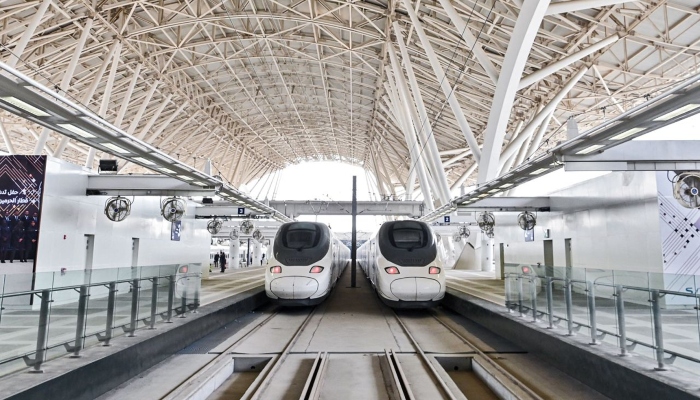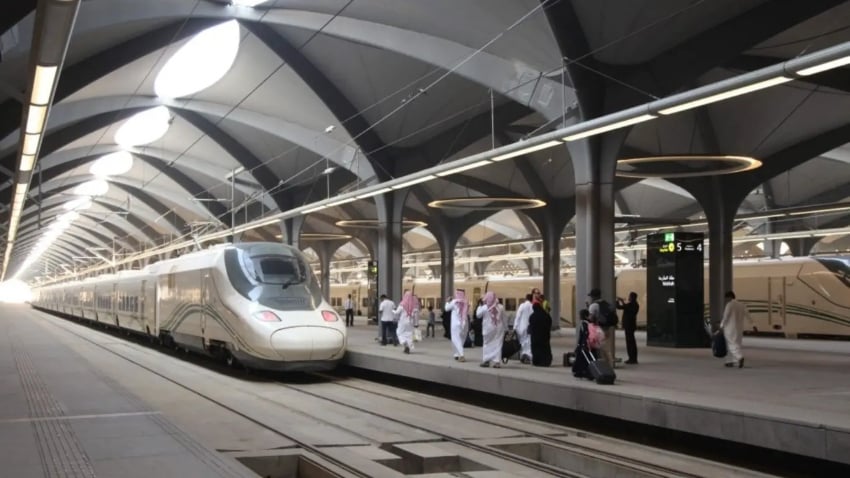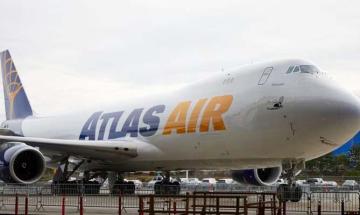Haramain High Speed Railway travel across Saudi desert
Haramain High-Speed Railway brings new experience of traveling on land in Saudi Arabia

These sleek, long-nosed javelins travel over Saudi Arabia's scorching deserts 50 times per day, carrying pilgrims and other passengers at speeds of up to 300 kph (186 mph).
The world's top ten fastest trains are just the start of a rail network that is projected to spread throughout the Middle Eastern nation as it invests billions in infrastructure to increase tourism and diversify its economy away from oil.
Religious pilgrims and vacationers alike may now transfer from the arrivals area of King Abdulaziz International Airport to a dazzling station where electric express trains hurtle out across the nation from Jeddah, the second-largest city in the kingdom.
All passengers can take advantage of the new Haramain high-speed trains on a 450 km (280 mi) route that runs along a portion of Saudi Arabia's Red Sea coastline, despite the fact that only Muslims are permitted to visit Makkah.
The Arabic word haramain, which refers to the two holy towns of Medina and Makkah, which are located on either end of the line, means "two sanctuaries." It also connects King Abdullah Economic City, Jeddah Al-Sulimaniyah (near the city centre), and Jeddah Airport.
So how is riding like?
Purchasing tickets is simple. The gold and white HHR Rail app is available in Arabic and English. The Gregorian calendar will be used if you select the English option, even though many Saudis only use the Islamic calendar. Bring your passport close by since you must enter your ID details before choosing "pay."
No one requested to see passports or other paperwork to board the train. An economy ticket between Jeddah Al-Suleimanyah and the King Abdullah Economic City (KAEC, pronounced similarly to "kaish") cost 57.50 Saudi riyals (about $15.30) on a normal weekday in early 2023, while a business class seat cost 97.75 riyals (around $26). Apple Pay and other types of digital wallets are supported by the app.
It's simple to select particular seats. The train car layout is displayed on the app, allowing users to select a window or aisle seat and pick whether or not they want to face the direction of travel. If available, the app will automatically choose seats close to each other when making reservations for families or groups.

Station to station
The stations along the route are comfortable, up to date, and effective. These are also lovely. According to rumours, the nearly identical Jeddah and KAEC stations were both inspired by diamonds. They were created by British architects Foster + Partners and feature angular, clean lines, sleek black walls, and tiny carvings in the ceiling that resemble stars and let various colours of light filter in throughout the day.
These hubs lack the bustling, lived-in atmosphere of a commuter rail station like Grand Central in New York City or Gare du Nord in Paris. Although the stations are beautiful, they are largely deserted.
As there aren't many amenities in the stations, people are more likely to arrive just before their scheduled trains than to linger for a while. Only a Dunkin' Donuts can be found at KAEC. With a few tea and coffee shops, including a Starbucks, and a supermarket, Al-Sulimaniyah in Jeddah is bustling. The train experience is vibrant and energetic, even though the stations may be beautiful yet a little lonely.
The pilgrimage track
From Jeddah to KAEC, a distance of 111 kilometres, it takes only 32 minutes to drive (69 miles).
Business class was rather quiet on a pre-Ramadan Thursday trip at around 2:00 p.m., but the economy class cars were packed, mostly with people travelling to Makkah for umrah. Umrah is an optional pilgrimage for Muslims who choose to travel to the holy city and the Kaaba, Islam's most revered location, unlike its more well-known counterpart, the hajj.
While Muslims are expected to perform the hajj at specified times of the year, the umrah is not required and can be performed whenever it is convenient. It is simple to determine which travellers were going to Makkah specifically for this purpose:
When performing umrah, men and boys are required to wear two unstitched white towelling cloths, and many shave their heads after returning. Similar white clothing can be worn by women as well, though it is not needed.
Families of various ages were crammed into the car while they entertained little children and listened to pop music in Arabic. Celebration-themed and upbeat music filled the air.
The railway now generates significant revenue from umrah. The Saudi Gazette reports that during the month of Ramadan, which takes place between mid-March and mid-May, HHR will operate more than 100 train journeys daily due to the strong demand for train tickets for religious pilgrims.
Even though it was less crowded, business class had more perks.
Business class guests are entitled to a full meal service, even on a brief flight like the one from Jeddah to KAEC. This includes hummus, a few rounds of pita bread, a croissant, a fruit cup, a chocolate chip muffin, and your choice of apple juice or water.
A uniformed attendant serves it from a beverage cart in the shape of an aeroplane. Small seat-back TVs are also available, but the only programming available on this journey is Paw Patrol, Formula E racing, or an Islamic sermon.
Just admiring the dusty scenery outside your window is a much better choice, especially on short trips. Yet, this isn't a leisurely journey through inaccessible areas. The Red Sea is just tantalisingly out of view, and you'll largely see Jeddah's suburbs rather than an open desert environment.
Both Arabic and English are used for all onboard announcements, as well as both languages for all signs. Once passengers have reached the railway platforms, uniformed staff members will direct them to their designated boarding area, assist with luggage, and assist with wheelchairs and strollers.
The seats in economy class are arranged two by two. Little tables are located where the centre rows meet to face each other, with half the seats facing forward and half facing backward. In contrast, the seating in business class is set up with two seats on one side of the aisle and one seat on the other.
Seats in both service classes include armrests and seat-back tables, while the ends of the vehicles have places to store luggage. The majority of the interior furnishings, including the seats, are white, pale gold, and tan, which complements the exterior's desert setting perfectly. An excellent way to describe riding the HHR train is seamless. There are no sharp curves or jolts; the train is silent and the ride is pleasant.
Steering into the future
There is a chance that their train may have a female driver even though passengers cannot see the driver. The first group of 32 women from the Saudi Railway Polytechnic's one-year training programme received their licences to operate fast trains on the Haramain network in January 2023.
In contrast, women in the kingdom had just recently started to drive cars in 2018, when the train line first started operating. The Haramain line in Saudi Arabia appears to be just the start of the country's high-speed rail system. Moreover, improvements are being made to the nation's northwest lines, and additional high-speed services are being considered. Saudi Arabia's Minister of Investment Khalid al-Falih announced plans to construct 8,000 kilometres in January 2022.








































